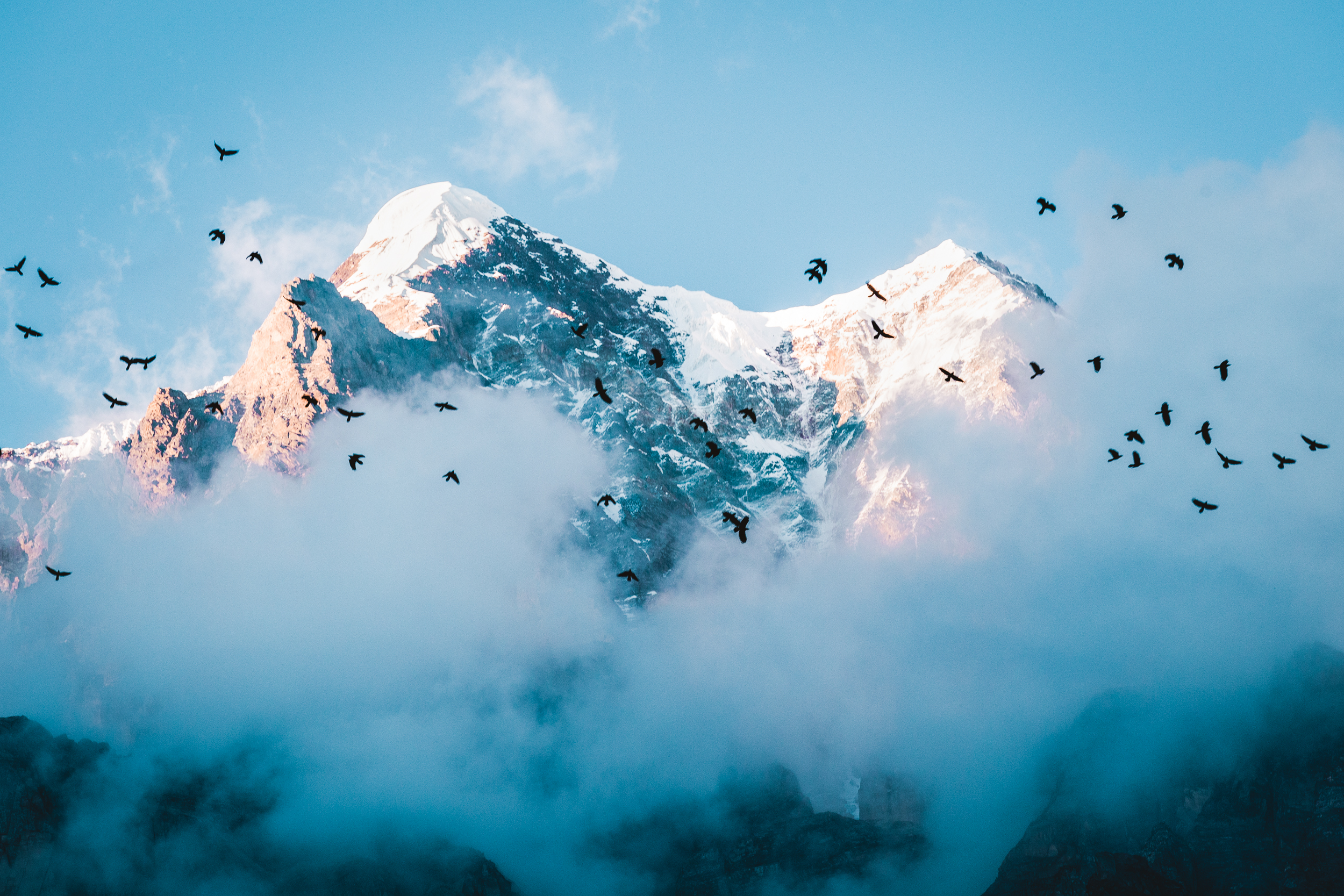The Himalayas: a landscape that is as characterized by its allure as it is its extremes. Likely to have crossed the mind of every adventurer at some point in their lives, these mountains at the top of the world feature dramatic landscapes and rich cultural histories as diverse as the land itself. In the stories of the villagers who inhabit these unforgiving environments, in the marvel of human strength it takes to stand atop the highest peaks on the planet, you can come to gain an intimate respect and understanding for the Himalayas by trekking it yourself.
Home to eight of the 10 highest peaks on the planet, Nepal is a trekker’s paradise!
When + Where to Go
Planning an international trip to trek in Nepal can sound daunting, but I am here to break it down for you. If you want to choose the simplest avenue, online tour operators offer organization of permitting and logistics for you, but these tend to be more expensive, can have larger group sizes, and leave less flexibility for tailoring your trip.
For those who want to organize their own trek, there are a few considerations to make.
The main trekking season in Nepal is in the fall from September through November, and the spring from March to May.
From May to early September, Nepal experiences monsoon conditions that bring heavy rain, landslides, and leeches.
Optimal trekking times can vary depending on the region, popularity, and elevation of each trek.
Some of the most popular teahouse treks include Everest Base Camp and the Annapurna Circuit, both of which can be done with or without a guide, are well trodden, and tend to be quite busy during peak season.
For less touristed treks, try the Manaslu Circuit, Tsum Valley, Langtang, Gokyo Lakes, or the Upper Mustang.
For treks of one week or less, Poon Hill and Mardi Himal are great options.
The logistics, permits, duration, and difficulty of each trek vary drastically, so please research beforehand! Here are the basics you need to know in order to plan a trek in Nepal.
A trekker at Phiren Phu, a monastery in Tsum Valley.
Permits
All foreign trekkers are required to purchase permits for any trek in Nepal. These can be arranged in either Kathmandu or Pokhara, and which ones you need to get depend on what trek you are going to do.
In general, trekkers need to purchase a TIMS (Trekkers Information Management Systems) card available at Nepal Tourism Board offices in Kathmandu or Pokhara or the TAAN Secretariat offices in Maligaon or Pokhara. You need multiple paper copies of your passport, Nepal visa, and at least four extra passport photos when you go to apply for permits. Fees need to be paid in Nepalese rupees, and credit cards are not accepted. Opening hours tend to vary unpredictably, especially during a public holiday, so give yourself a couple of days before you intend to trek to organize permits and logistics.
Additionally, Conservation Area Permits are required for many trekking areas, including Annapurna and Manaslu, and they can be purchased separately at the Nepal Tourism Board office. It should also be noted that Special Trekking Permits are required for some restricted areas like Tsum Valley and the Upper Mustang, and there are additional requirements that include a group of two or more trekkers, a licensed guide, and permits to be purchased through an agency.
Children playing in a village in Tsum Valley. The people of Nepal are kind and generous with trekkers.
Logistics
There are a slew of challenges and confusions that may arise concerning your trek, and the best advice is to just ask a local or trekkers returning from the mountains.
The Nepalese are among the kindest and most welcoming people in the world, and while there may be a few bad seeds out there, most are truly happy to share information and make your experience great. Trekking companies have the most detailed information for you, and while they share in order to gain your business, be appreciative and respectful of their efforts. Don’t feel pressured from the first company you encounter to book with them unless you feel so inclined, because prices and itineraries can vary!
A tour company can help you plan a specific trekking itinerary, including where to stay, how to pace your days, what to expect, transportation to and from the trailhead, hiring guides and porters, and help navigating the permit system. A great, honest, and extremely knowledgeable company I do recommend is Rustic Himalayan Adventure based in Kathmandu.
A tent camp at Dharamsala (4,400 m) on the Manaslu Circuit.
Health + Safety
With Everest Base Camp at 17,598 feet in altitude and the Thorong La Pass of the Annapurna Circuit even higher, altitude sickness is a real concern and should not be taken lightly.
Take precautions like drinking a ton of water, acclimatizing as you ascend (especially as you reach higher altitudes), and eating extra healthy even when your appetite wanes! If you experience signs of altitude sickness, like nausea, dizziness, or a headache, you may need to stop your ascent to allow your body time to acclimatize, and in more serious cases, descend to a lower altitude to rest.
Preventative medicines for altitude sickness like acetazolamide (Diamox) may be used at your discretion, and sometimes the side effects are unpleasant. If you plan to take them, begin two days prior to the start of your trek or they won’t work. Natural alternatives involve ginger, garlic, and chloroxygen, a supplement derived from chlorophyll that is supposed to boost your red blood cell count to better absorb oxygen.
Additionally, travel insurance is a good idea to have in case of emergency, as a helicopter lift out of the Himalayas can cost a fortune! Make sure that the plan you choose covers high-altitude trekking. Carry medical supplies like antibiotics, antiseptic wipes, bandages, moleskins, and anti-inflammatories in case you or anyone you run into needs them.
Food
Unless you are planning to do a camping trek, most experiences in Nepal are “teahouse treks,” where you will be able to find accommodation and home-cooked meals. Do as the Nepalese do and feast on the tasty staple that is dal bhat, essentially a mixed plate of rice, lentils, vegetables, and anything the cook wants to throw in! Steer clear of dairy and anything that isn’t made with fresh ingredients, as food poisoning does happen and it can be a nightmare.
Yes, that pizza or burger calling your name at 14,000 feet may sound tempting, but take it from me: It’s not worth it! As far as snacks go, feel free to bring high-energy snacks like nuts, berries, or protein bars, but keep in mind you will be carrying it up into the mountains, and every pound counts in your backpack.
The contents of a trekker's pack.
What to Pack
Once plane tickets have been purchased and permits are under wraps, the biggest concern is what to pack!
As you might suspect, trekking boots and a comfortable backpack (in most cases 30 to 50L) are at the top of the list. Make sure to break your boots in before setting off to avoid blisters and discomfort on the trail. It’s a well-kept secret until you hit the ground in Kathmandu and Pokhara that decent-quality clothing and trekking gear is sold very, very cheap!
For everything besides your boots and backpack, and if you have a couple of days to spare before you begin your trek, I would highly suggest saving money by purchasing (or renting) in Nepal the gear you will need. Keep in mind that it is commonplace in Nepal to barter when making purchases, so try to ask a local what items should cost and whether a shop is “fixed price” or you can negotiate.
Items like sleeping bags (get one rated to zero degrees), a headlamp, gloves, base layers, trekking pants, socks, hats, fleece and down jackets, and buffs can be found in the street markets and shops in the main tourist neighborhoods of Thamel in Kathmandu and Lakeside in Pokhara. Water-wicking, quick-dry pants and shirts are a good idea, as is a base layer combined with a fleece or wool mid-layer and a hard shell on top.
For short treks under a week, you probably won’t need to wash clothes, but for anything longer I’d suggest bringing a bar of soap to hand-wash undergarments and socks at the end of the day. Try to dry them in the sun or air dry overnight. Cotton is only good for sleeping in, as it takes a long time to dry when you sweat.
The Milky Way splashed above the eighth tallest mountain on the planet: Mount Manaslu (8,106 m).
Last Words
Buy a trail map and familiarize yourself with your route, including where to stop for lunch and stay overnight.
Plan for extra days in case unforeseen circumstances arise or bad weather slows you down.
Bring sunscreen and a hat. The sun can be quite strong.
Bring enough Nepalese rupees with you to last your entire trek. Accommodations and food are cash only (budget $30 to $50 per day).
ATMs in Kathmandu and Pokhara are frequently down, so bring currency to convert if you are able.
Guides usually cost around $25 to $35 per day, and porters cost $15 to $25. A tip of at least 15% is standard.
Batteries drain quickly in the cold, so keep them against your body or in your backpack. Maybe bring a power bank.
The chance to charge electronics, use Wi-Fi, or take a hot shower is scarce and tends to cost money ($3 to $5).
Bring water purification tablets or a water filtration system with you, because bottled water is expensive.
Alcohol can intensify the effects of altitude sickness, so steer clear until you are at low altitude.
When donkey or yak caravans pass you on a trail, make sure to stick to the cliff as you allow them to pass.
The more research you can do before embarking on a trek into the Himalayas, the better. It is bound to be the adventure of a lifetime, as it was for me, and may have you itching to return back to where you left your heart—up in the mountains.
For other exciting adventures in Nepal, check out the ultimate Nepal bucket list.
Let this serve as a spark to book that plane ticket to Kathmandu and begin planning your trek up into the incredible Himalayas of Nepal!
This article was originally written for and featured in Outdoor Project.

